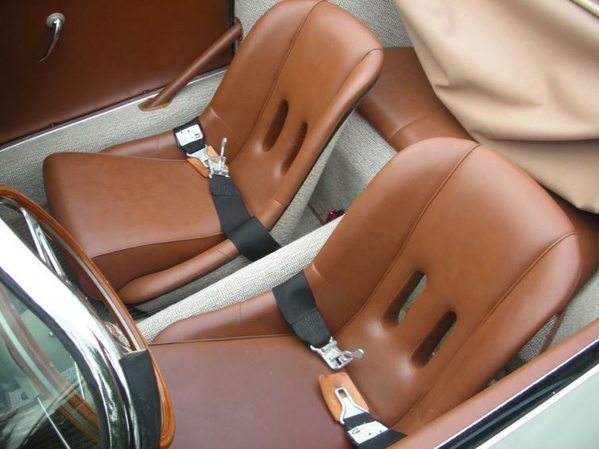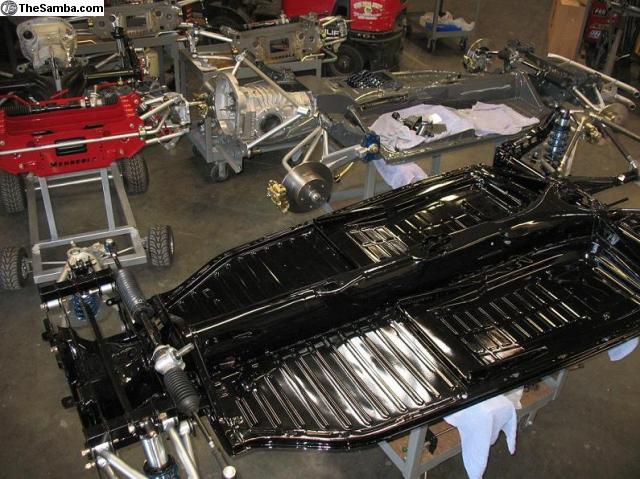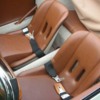First time post, and I’m about to dive head first into this addictive hobby. I’m about to purchase the buildup of a speedster and I’m trying to weigh all of my options. I live in Ca so registration tends to play a factor, but not entirely. My ultimate goal is to build a great handling, fun, drivers car, with ample power, but still keep the nostalgia of a speedster. I have scoured the online information, and I’m really wondering what the main differences, are between the different build offerings. I see some offer a tube chassis, while Some offer the reinforcement bonded to body. There is a modified pan, with some bolt on reinforcement, while some are offered inside the body. There is a lot of options.... I do like the idea of a modified pan, but is there a lot of performance, and longevity left on the table by not going tube? I’m going to be doing a 160-190 hp T1, Disc brakes, and a built transaxle of some sort. And plan on keeping this car for a long while, so I want to do it right the first time. Any recommendations on chassis, Pros/cons, and suspension setup is appreciated.
Replies sorted oldest to newest
With the subframe that Speedsters come with I don't think there's going to be much difference in handling when similarly outfitted- a pan car with VW components is going to be as stiff as a chassi'd car. If you happen to look at a Speedster where the subframe isn't already bonded to the fiberglass- I think having the structure replicated out of aluminum so the car weighs some 60 or 75 pounds less overall (al is less than 40% of the weight of steel) would be worth looking into. A brace from the door jam to the sill would also help- 
A kafer bar that ties into the frame horns, top shock mounts and the torsion bar tube would stiffen things up as well, and you could even tie the rear roll bar supports into it. In the front- outer beam supports. That's all I can think of at the moment.
Hope this helps. Al
PS- if noboby's said it yet- WELCOME TO THE MADNESS!!!
Attachments
Welcome to the Madness, but have you discovered our "Search Function"?
Little "spy glass" on the right of the black menu bar at the top of the page.
Try entering "difference between builders" and go from there. All of your questions have been covered in the past.
Thanks @ALB that’s exactly the information that I was looking for. @Gordon Nichols Since I’m familiar with how the various builders achieve the end result, I’m really looking For the advantages/drawbacks of each Design , since I’m building this myself, I’m more interested in the design, construction, and engineering of each offering, vs. the builder customer relations, and finish work. I’ll comb through more of the posts to see if I can answer my questions. I appreciate your help everyone. I’m beyond excited 😆
Generally a VW pan based car is easier to register both in CA and rest of world. Some new tube chassis built cars are getting away from the 50 year old VW bits front and rear - so they offer better handling. You can do the same using a VW pan and adding aftermarket non-VW bit s (like from Mendeola). Rich D (here) did a red VW Karmann Ghia with such a suspension.



SAW/SAS (some used cars are available - don't expect to ever receive a new build) is interesting in that on their Subaru powered cars they tried to use as much of the donor Subaru chassis as possible - trans, brakes even SBS, wheels, etc. NEVER EVER write a check to Steve Lawing of SAS though!!!!
WTTM.
It seems like you'd like to build your own car. There aren't as many options as it would first appear.
In the 70s, Frank Reisner closed down Intermeccanica as a coach-builder in Turin, Italy, and moved his family to SoCal. He partnered with a guy named Tony Baumgartner to form Automobili Intermeccanica and built about 600 speedsters. These were the original speedster replicas and all were pan-based, and had a subframe glassed into the body. Frank Reisner sold his stake of the operation to Mr. Baumgartner, who sold to Classic Motor Carriages (CMC) who moved production to Florida. The cars' construction remained virtually identical.
There were lots and lots and lots of CMC kits sold. I'm not super up to speed on the idiosyncrasies of FiberFab as it relates to CMC, but those (very few) cars were pretty much identical as well.
CMC was eventually closed, and a company called Street Beasts rose from their ashes. Street Beasts had a different subframe than the CMC cars. If I'm not mistaken, all of their cars were widebodies. There were not very many of these sold, and they were all kits. It would be exceedingly rare to run across one.
Frank Reisner moved to Vancouver and in 1981 started building '59 Convertible D replicas on VW pans. They were very similar to the Automobili Intermeccanica cars. In 1985, the Reisners (Frank and his son Henry) developed a full tube frame, which utilized a beam and rear torsion bars from a VW, but nothing else. If I'm not mistaken, all Vancouver IMs use IRS rear suspensions. As time went on, they also began building some cars with 911 running gear, including the front torsion-bar setup from early 911s. The water-cooled cars that came out in the '00s were set-up with 914 front running gear. All tube-framed IMs are wider and lower in the seating area and footwell than the Automobili Intermeccanica (and CMC/FiberFab and VS/JPS cars). They also have the engine and transaxle slid forward in relation to a pan-based car (for better weight distribution). IMs are hypothetically available as a "coach" (body and interior only), but I think I may have bought the last one actually built in 2005.
The original Kirk Duncan Vintage Speedster were built in Hawaiian Gardens (LA) beginning in the early '90s until a couple of years ago. It's impossible to know how many kits CMC sold, but it is clear that far more Vintage cars were built than any others, because the vast bulk of Vintage Speedsters were built as turnkeys. Vintage kept the same basic pan/subframe layout as the LA IMs and CMC/FiberFabs, but laid up the fiberglass by hand rather than by chopper-gun like IM and CMC/FiberFab. JPS used VS bodies/subframes when they were in LA, so they were identical. CMC developed a "California Widebody" with flares. Vintage Speedsters had a "Super Widebody" with even bigger flares.
Kirk sold Vintage to a guy in Arizona who fired all the former workers and moved production to his own shop in Scottsdale. Enter Greg Leech of Vintage Spyders, who hired all of Kirk's former workers, moved into Kirk's (now empty) shop, and started building better and more refined versions of Kirk's cars in addition to Spyders and coupes. Greg's company is called Vintage Motorcars (much to the confusion of a lot of folks). Greg will sell a kit-- but as with almost everybody in the business, nearly all cars are built turnkey.
Thunder Ranch (in greater San Diego) did their own thing (different body), but they also used a pan and subframe. Very late Thunder Ranch cars (from about 2005 on) used a David Barrett pan-replacement frame, which used the VW pan from behind the seats back so that there was a VW serial number. The footwells and seating area are nice and wide in these cars.
Thunder Ranch sold and went through several permutations before Chris Kleber eventually bought what was left and formed KitMan Motors. KitMan sells speedster and coupe bodies-- both use VW pans. They offer two frame options: a very minimal subframe for use on a pan, and a pan-replacement which uses the serial number portion of a VW pan. Both don't offer a lot of structure that other pan-based cars have, but they are super-lightweight and have some really neat features (like a widened seating area and footwell), and offer a nice platform to build off of.
As an aside, it's super-hard to fit 5-1/2" wheels under the back of the classic bodied pan-based cars, so the vast bulk of them use swing-axles. It's not unheard of for somebody to have an IRS pan-based classic body, but they've usually gone to great effort to get things to fit (narrowed trailing arms, etc.), or they run narrow wheels. JPS used to do a classic-body with IRS and EMPI disc brakes, but they almost all had 4-1/2" rear wheels, and it was impossible to slide a credit card between the body and the tires in the back. The widebodies have no such issues, and apparently there are IRS widebody VSs.
... which brings us to Special Edition (Beck). There was a company called Chamonix, which was founded in Brazil in 1987 by Milton Masteguin (formerly with Puma Cars) and Chuck Beck, which produced Speedsters and Spyders designed by Chuck Beck and sold in the US by Beck. Carey and Kevin Hines took over from Chuck and formed Special Edition, in the beginning importing semi-finished Chamonix speedsters from Brazil and finishing them in Breman, Indiana. Eventually, more and more processes moved to Breman, until ultimately the entire car was built there. The original frame and body continued to evolve, until this year. Pre-2020 Beck speedsters had 3" DOM round tube frames, VW beam front ends, swing-axle rears and the widest cabin and footwell in the business.
Chamonix is still in business, apparently-- building cars sold here as JPS Classics (or something) now. JPS is also still doing custom builds, still using pans and the Vintage bodies.
Special Edition (Beck) is now building a Chuck Beck/ Carey-Kevin Hines designed Speedster with a coil-over A-arm front suspension and coil-over IRS rear suspension in either a mid-engine or rear-engine configuration, utilizing either an air-cooled or water-cooled engine and a VW or Subaru transaxle. They have lower seating areas and remain wide and roomy. Apparently (as per Carey last week), they also can utilize the serial number portion of a VW pan for registration purposes. It's the Swiss army knife of replicas, and seems to be pretty amazing in every configuration.
You may be able to find an unbuilt CMC (there used to be a lot of them), but the supply is thinning. I think as of right now, your choices for a new kit are:
- A pan car with the classic sub-frame from Vintage Motorcars
or
- A pan with a minimal sub-frame from KitMan
I'm not sure if IM or Beck will sell an incomplete car anymore, and I know JPS won't.
I'm sure there's more to know that what I've outlined, but I'm also pretty sure that's enough to get you started.
Thank you @WOLFGANG those suspension setups are drool worthy. @Stan Galat that is an incredible amount of history, and great information. Thank you! That definitely gave me the information that Needed, to make my purchase.!
Eric, the suspension pics Wolfgang posted are from CoolRydes Customs in San Diego, CA.
https://www.coolrydescustoms.com
The owner, Kevin Zagar, is a fellow SOCer and a cool dude. Check out his products and add it to your research data. Looking forward to watching your project progress, with pics of course! ![]()
It looks like the Mendeola front would allow the use of a Super Beetle pan. They are often more readily available over the older std front end pan. Might even get one with the more desirable 3.875 R&P transmission.
@Stan Galat, I did not have to go to great lengths to put 5 1/2" wheels on the back of my IRS CMC classic bodied Speedster.
I thinned the edge of the wheel opening a little bit. I bought 5 1/2" Mangel type wheels from the Beck folks. Compared to 4 1/2" Mangel wheels, these have the additional inch all toward the inside. I don't know if these wheels are still available from them.
I run 175/70 tires and have about 3/8" clearance on the driver's side.
That's great news, Michael, and worthy of a correction. Do you run rear disc brakes?
@Stan Galat, I do have rear disc brakes. I installed the Socal/AC rear disc brakes even though heavy. Unlike others, they claim to not increase the track. Even so, they shaved a little off the wheel mounting surface to match a drum after I told them how important this was to me.
I'm leaning towards the Vintage 190's in a 5.5" that VMC offers. I reached out to him to see if there would be any issues with fitment, on his IRS pan. Especially since i wanted to lower the stance a bit.
Looks like the Vintage 190's all have 4" back spacing. That would mean the extra inch is towards the opening (outside) on the 5 1/2" ones. (I double checked and both ate 4"). You could mock one up in card board to test.
EMPI and CIP have fake Fuchs (911 5 bolt) that has a 5" back set.
I agree Wolfgang. In order to use them, you need short swing axles on a Spyder.
Since I have them, I'll confirm that the extra inch on the 5.5" is to the outside.
I believe most of the rear brakes are zero offset, it's the fronts that WILL widen the track. Every. Single. One.
Which is why a 2" narrowed beam is needed with most discs, at least on a Spyder. The Speedster appears to have more room in the front compared to a Spyder.
@DannyP posted:I believe most of the rear brakes are zero offset, it's the fronts that WILL widen the track. Every. Single. One.
Lots and lots of rear brakes kits advertised as "zero offset" add a half-inch per side.
OK, didn't know that. I do know for a fact that Airkewld rear kits add zero to the width.
Their fronts, however, do add 5/8" or 3/4" a side, on a drum brake spindle.
@DannyP posted:OK, didn't know that. I do know for a fact that Airkewld rear kits add zero to the width.
Their fronts, however, do add 5/8" or 3/4" a side, on a drum brake spindle.
That's part of why I used the Airkewld set-up. Greg tells me I can fit 5.5" Vintage 190's and a 185 (maybe a 195) with the narrowed IRS, and with the right offset a 15X6 wheel and 195 will fit under the fenders of the pre-A coupe. Another reason is that I can change the stud pattern to a 130X5 or a Chevy 112X5 bolt pattern very easily. The smaller diameter lug patterns will add 0" offset to the front, the current wide 5 set up measured out at plus 5/8" a side up front and 0" out back.
@JMM (Michael) Did you get a 2" narrowed beam to go with those front brakes?
And yes I like the exchangeable bolt patterns, that's really a cool feature of Airkewld.
I can fit 195s up front and 205s in the rear on my VS (wide five disc brakes front and back) after narrowing the rear trailing arms 1 1/4" and using a 2" narrowed beam. It was a lot of work but the wide tires look so good.
@DannyP posted:@JMM (Michael) Did you get a 2" narrowed beam to go with those front brakes?
And yes I like the exchangeable bolt patterns, that's really a cool feature of Airkewld.
No, Danny, I didn't. Greg said there's plenty of clearance up front on the pe-A coupe. The trailing arms were narrowed 1 1/2" of course.
I imagine that at some point I'll use the excuse that 15" sticky rubber is too hard to get to justify something like this in a 16" 130 bolt pattern and staggered widths. I could do anything I wanted with backspace and off-set to get things to fit.
I went with the same 4 pot front set-up you have based in large part on your review of them in track use. So thanks for sharing!
Michael, did you have to do any machining in the seal and dust cap areas?
@DannyP posted:Michael, did you have to do any machining in the seal and dust cap areas?
i had it all shipped directly to Greg. He said that Pete got everything in the box and that it all went together without any issues. It didn't't sound like he had to do any machining. What's the issue that needs addressing with those areas?
My seals didn't quite fit right. I had to open the hole up 0.020" or so, maybe more. I don't recall exactly, but it was enough that the seals popped back out after installing. I cut them with a purposely rough finish to give the seal some extra "bite".
On the dust cover side, the nub that the dust cap fits on was way too tight(large). The finished/polished hub leaves nowhere to pry on. So I machined the hub down for a slip fit, and keep the dust caps on with clear RTV. The RTV sticks well, but peels off easily.
I did have to remove the wide5 bolt patterns to fit the hubs in the lathe. Of course I indexed everything so it went back the same. Then new red loctite and torqued all the bolts.
I'm guessing they changed some settings on the CNC lathe since I purchased mine. That's a GOOD thing!


